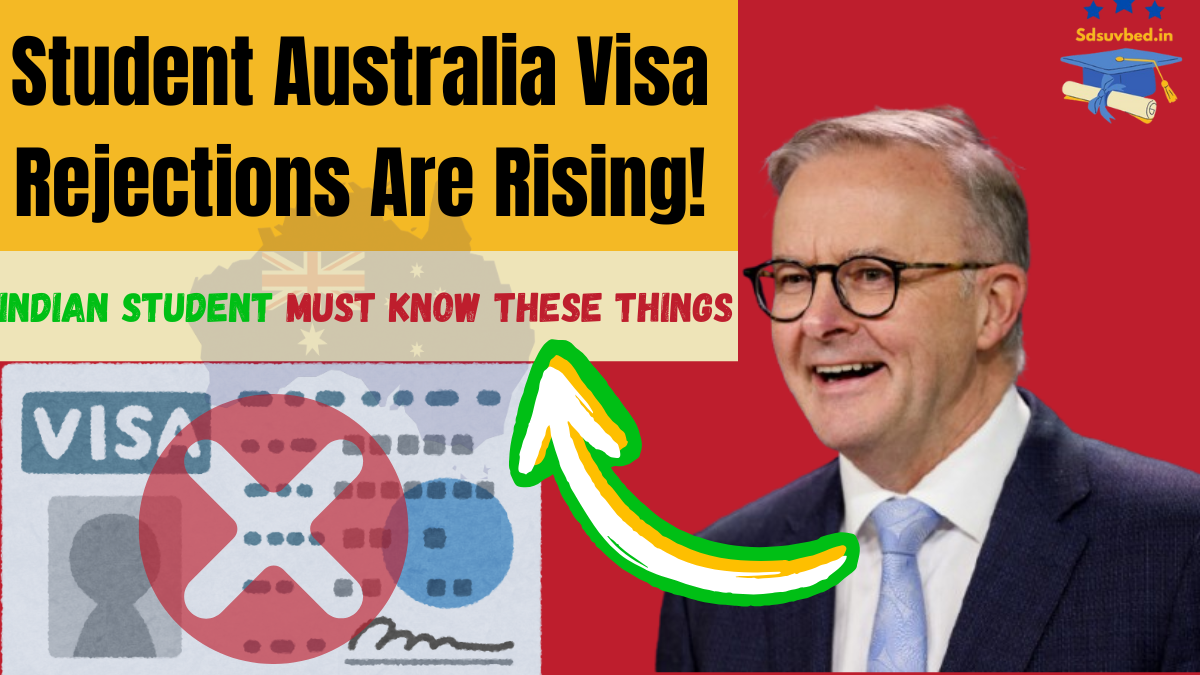In recent years, Australia has tightened its visa policies, resulting in a higher rejection rate for student visa applications from India. While Australia remains a top destination for higher education, stricter immigration rules and increased scrutiny have made the approval process more challenging. Several key factors have contributed to this rise in rejections.

Key Reasons for Increased Student Visa Rejections
Stricter Immigration Policies
The Australian government has introduced tighter rules to control migration, including changes to student visa requirements. Applications are now being thoroughly scrutinized, with authorities rejecting those that do not meet the eligibility standards.
Financial Proof and Insufficient Funds
Applicants must demonstrate adequate financial resources to support tuition fees, accommodation, and daily expenses. If a student fails to provide clear evidence of financial capability, their application is likely to be rejected. Banks statements, sponsorship letters, and proof of funding sources must be accurate and verifiable.
English Language Proficiency Requirements
Australia has strict English language requirements, and applicants must score at least the minimum required band in tests such as IELTS, TOEFL, or PTE. Many applications are rejected due to low scores or failure to submit valid test results.
Genuine Temporary Entrant (GTE) Requirement
The GTE requirement is one of the most crucial factors in visa approval. Students must convince Australian immigration officials that their primary intent is to study and that they plan to return to India after completing their education. A weak or unclear GTE statement often leads to visa denials.
Selection of Course and Institution
The choice of course plays a vital role in the approval process. If an applicant’s selected program does not align with their previous education or work experience, it raises red flags for visa officers. Additionally, applying to institutions with a high visa rejection rate can negatively impact approval chances.
Past Immigration History
Applicants with a history of previous visa rejections (for Australia or other countries) are more likely to be denied again unless they clearly address the previous reasons for rejection.
What Steps Can Indian Students Take to Improve Their Visa Approval Chances?
Despite the challenges, Indian students can take proactive measures to improve their likelihood of visa approval.
Submit Complete and Accurate Documentation
Incomplete applications are a major cause of rejections. Ensure all personal, financial, and academic documents are correctly submitted, verified, and up to date.
Demonstrate Sufficient Financial Proof
Applicants must provide solid proof of funds, including:
- Bank statements showing sufficient balance
- Proof of educational loan approval (if applicable)
- Sponsorship letters from parents or legal guardians
- Fixed deposits, property documents, or other financial assets
Improve English Proficiency Scores
A higher IELTS, TOEFL, or PTE score can significantly improve approval chances. Consider retaking the test if your score is lower than required.
Write a Strong GTE Statement
A well-structured GTE statement should:
- Clearly explain your motivation for studying in Australia
- Justify how the selected course aligns with your previous education or career goals
- Reassure visa officers about your intent to return to India after completing studies
- Include supporting evidence, such as work experience or a business plan if applicable
MUST READ: Australia’s Work Visa Hack – Indians Are Using This Trick to Get Approved Fast!
Choose Your Course and Institution Wisely
Select a course relevant to your academic background or career aspirations. Research the visa acceptance rate of the university before applying.
Seek Expert Assistance
Consulting education agents and immigration specialists can help navigate complex visa procedures, identify mistakes, and strengthen the application.
FAQs
What is the current rejection rate for Australian student visas for Indian students?
Recent reports indicate that the rejection rate has reached 24.3%, making it the highest in over a decade.
How important is the Genuine Temporary Entrant (GTE) requirement?
The GTE requirement is critical, as it helps visa officers assess whether an applicant is a genuine student or intends to use the visa for other purposes. A strong GTE statement improves approval chances.
Can I reapply if my Australian student visa is rejected?
Yes, you can reapply after addressing the reasons for rejection. It is advisable to consult an immigration expert before reapplying.
Does the choice of course or institution affect visa approval?
Yes, applying for a course unrelated to your previous studies or work experience can raise concerns, leading to a rejection. Additionally, institutions with a high visa refusal rate may negatively impact approval chances.
Are there alternative study destinations with lower visa rejection rates?
Countries such as Canada, the UK, and New Zealand have relatively lower rejection rates and may be good alternatives for Indian students.
How early should I start the visa application process?
It is recommended to start the process 6-12 months before the course commencement to allow time for documentation, test scores, and application review.
Do visa application fees get refunded if my application is rejected?
No, Australian student visa application fees are non-refundable, even if the visa is denied.
Can work experience improve my chances of visa approval?
Yes, if your work experience aligns with your chosen course of study, it strengthens your application and improves approval chances.
By taking the right precautions and preparing a strong, well-documented application, Indian students can improve their chances of securing an Australian student visa and achieving their study abroad goals.
Click here to know more.
A passionate content writer specializing in creating engaging, SEO-optimized content. With expertise in blogs, web copy, and storytelling, I craft words that connect with audiences and deliver results.
